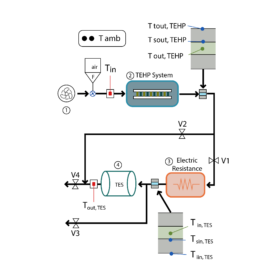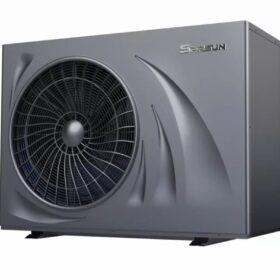Thermoelectric heat-pump boosters can increase supply-water temperature in district heating by 10 C
A Slovenian research group has proposed using a heat pump booster instead of vapor compression technologies in low-temperature district-heating substations and has found that this combination may raise the supply-water temperature from around 32 C to 42 C. In the proposed system configuration ten single-stage Peltier modules were used, each with a maximum cooling power of 165 W and a maximum electric power of 289.2 W.
Testing zeotropic fluids in high-temperature heat pumps
A German-Nigerian research group simulated the usage of mixtures of zeotropic fluids with varying boiling or condensing temperatures in industrial heat pumps. The best results were obtained with a mixture of cyclohexane and cyclopropane.
Spanish scientists develop thermoelectric heat pump for thermal energy storage
A Spanish research group has investigated how thermoelectric heat pumps may be used as power-to-heat technology to increase temperatures in thermal energy storage systems. It found the proposed system configuration may achieve an overall efficiency of 112.6% at at 135 C.
Daikin debuts residential air-to-air heat pump
The Japanese manufacturer claims the new product has a seasonal energy efficiency ratio of up to 9.47 and a seasonal coefficient of performance of up to 5.20.
TICA introduces air-to-water heat pump for residential applications
The Chinese manufacturer said its new heat pump has a coefficient of performance of up to 5.3 and a maximum heating capacity of 16 kW. It can reportedly achieve a topwater output temperature of 80 C.
Sprsun launches residential air source heat pump
The Chinese manufacturer said its new heat pump has a coefficient of performance of 4.2 at 7 C and a maximum heating capacity of 9.1 kW. It can reportedly achieve a topwater output temperature of 75 C.
Panasonic reveals new air-to-water heat pumps
The new products are intended for commercial applications and and multi-dwelling buidlings. They have a size of 20 kW to 30 kW and use R290 as the refrigerant.
U.S. Boiler unveils hydronic heat pump for residential applications
The US-based manufacturer said its new heat pump system has 5-ton capacity and a coefficient of performance of up to 3.95. It uses difluoromethane (R32) as the refrigerant and relies on DC inverter enhanced vapor injection (EVI) technology.
LG presents residential air-to-water heat pump
The system uses difluoromethane (R32) as the refrigerant and has reportedly a seasonal coefficient of performance of up to 4.69.
Hybridizing thermoelectric generators with photovoltaic ground-source heat pumps
Researchers in South Korea have analyzed the feasibility of using thermoelectric generators in combination with residential solar-assisted ground-source heat pumps and have found that the thermoelectric devices may act as a suitable power source for data loggers and other sensors in a building system.










